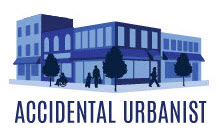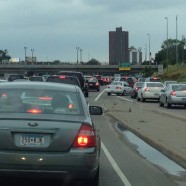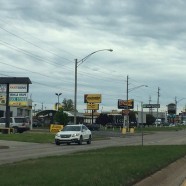America’s Love Affair with Our …Dishwashers?
“Americans love their cars!” We hear it so often, we don’t even pause to think how false that statement is.
I own a car. I also own a refrigerator. And a lawn mower. I appreciate all three for what they’re worth. But love? Not so much.
(Funny that no one ever talks about “American’s love affair with their dishwashers.” Substitute any other appliance and it starts to sound kinky. Try it at a party; then watch as people suddenly take a keen interest in the guacamole tray on the other side of the room.)
We don’t love our cars; we love convenience and independence. We love the freedom to move when and where we please. And we want to get there quickly and efficiently. This is an important distinction.
We don’t drive because we love our cars, we drive because—for the past 60 years or so–an entrenched system of financial incentives and public policy has ensured our dependence on the automobile.
First, cities adopted zoning codes that “separated uses.” This means that–for the first time–residential and commercial spaces could no longer co-exist. Modern zoning prevented people from living above a store, and walking across the street to work. Next, because everyone had to drive to every destination, we began prioritizing parking lots over people. Finally, lenders encouraged suburban “greenfield” development, making it easier to build sprawl than to reinvest in older areas of the city.
The result? We have created cities that are so spread out, we must travel great distances to fulfill our most basic needs. Whether we love or hate our cars, most of us need one just to get through the day.
Meanwhile, generations of inadequate funding have left our transit system operating on scraps. While we have invested billions in extending, widening and repaving streets for cars, we have failed to make comparable investments for transit, walking and biking.
So we shouldn’t be surprised when our underfunded transit system fails to deliver fast and efficient service. Imagine what our streets would look like if we hadn’t continually invested in them for the past 70 years!
It’s time for a change.
It’s time we stopped equating America, freedom and independence with the automobile. (It’s a tired old trope that fails to consider the very real burden that cars place on individuals, communities and the environment.) It’s time we started an honest conversation about transportation and the needs of people. And it’s time we started designing our cities, streets and neighborhoods for people, not parking. Only then can we make transit, walking and biking into viable options that will reduce auto-dependency moving forward.
The next time you hear someone talking about how much Americans love their automobiles, you can be ready with a retort: “America should be a place for people, not a place for people to park their cars.”
– Sarah Kobos
Read MorePriorities
Give this a try. Ask someone what’s most important in life. Then listen to their response.
Most likely, they will talk about the people they love. They will mention their spouses, their kids, their parents, their friends and their neighbors. Many will focus on their role as providers or caretakers. They may talk about their jobs, their faith, or their health. Or, you’ll learn about their passion for art, or gardening, or the local sports team. Others will talk about community: their favorite charities, the problems they want to solve, or the people who have made a difference in their lives.
You can quickly see a trend. Our priorities tend to center around family, community, connection, health, purpose, and joy.
With that thought in mind, take a fresh look at the city you call home.
Unless you’re lucky enough to live in a historic neighborhood or a traditional downtown, you’ll quickly see a disconnect between our values and the way we build our cities and towns.
That’s because–for the past 60 years or so–we have failed to design our environment for the people we love. We have failed to prioritize family, community, connection, health, purpose and joy. Instead, we have focused almost entirely on the movement and storage of cars.
Don’t believe me? Look around. What are the defining characteristics of the city you call home?
Wide streets, giant parking lots, enormous signs, and huge buildings dominate the typical suburban landscape. They dwarf us.
Future archaeologists will scratch their heads in wonder, puzzling over what strange species called this place home. The greatest scientific minds will excavate our cities and determine that the average human was 17 feet long, 6 feet wide, 5 feet tall, and traveled at speeds between 45 and 80 MPH. They will conjecture about the strange religious customs that required us to segregate our activities–preventing us from working or shopping in the vicinity where we lived or raised our young. They will marvel at our ability to construct concrete edifices, but wonder about the geo-political threats that must have caused us to disperse so widely across our territory.
What else could explain this ridiculous thing we’ve created?
We have dedicated millions of acres of land to asphalt. In doing so, we’ve created places where it’s not safe, much less desirable, to walk. Instead of bringing people together, we have created barriers. Sadly, we have created places where you need a car to cross the street.
We seem to care more about cars than ourselves. We have robbed ourselves of the pleasure of physical activity. (Would you rather drive to the gym, or walk to dinner?) Meanwhile, we have engineered an epidemic of obesity and chronic disease by making it impossible to get from place to place on foot.
In doing so, we have robbed our children and our elders of their ability to live independently. Instead of enjoying a purposeful, connected life, those who can’t drive become prisoners in their own homes. Unable to work, socialize or shop without driving, many become isolated and disengaged from their communities.
Meanwhile, the ever-increasing cost of maintaining roads and providing police and fire services to far-flung areas depletes municipal budgets. The parks budget is inevitably the first thing cut. Again, we provide for automotive travel, but not safe, enriching places where our children can run and play and make new friends.
We have systematically engineered the least efficient, least sustainable, least logical, and most expensive transportation system imaginable—and then designed our homes, businesses, schools, churches and parks to support that design.
We’ve made a mistake.
It’s time we started thinking about this. It’s time we started asking questions and demanding more.
We can fix it, but it won’t easy to overcome the powerful inertia of the status quo. It’s going to take knowledge and passion and dedication. It’s going to take a lot of people engaging in the process of shaping their communities.
It’s taken us 60 years to get to this point, so transformation won’t happen overnight. But we’ve got to start somewhere. So why not here? Why not now?
It’s time.
Read More

